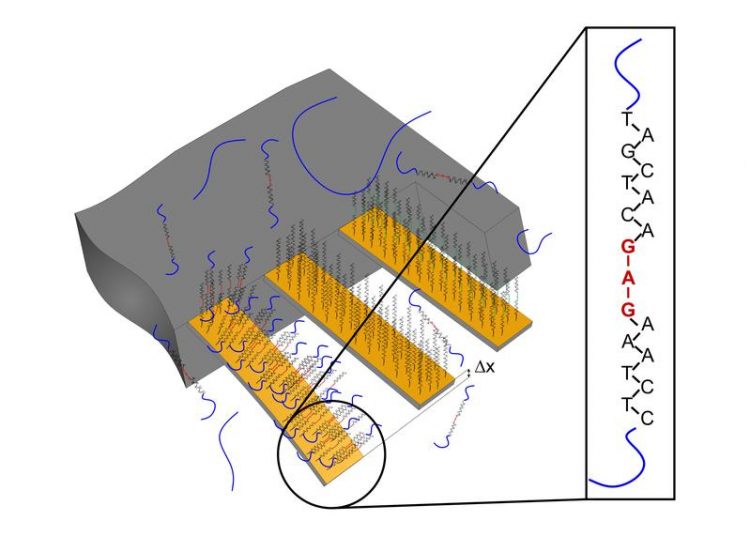Nanotechnology Supports Treatment of Malignant Melanoma

The cantilever bears the recognition sequence for the target mutation. If this is present in the sample, the corresponding segment of RNA binds to the cantilever, causing the latter to bend. University of Basel, Department of Physics
According to estimates by the American Skin Cancer Foundation, today more people develop skin cancer than breast, prostate, lung and colon cancer together. Although malignant melanoma accounts for only about 5 percent of skin cancers, these are the most serious cases and can result in death.
Around half of all patients who develop malignant melanoma exhibit a particular genetic change (mutation). This involves a change in the BRAF gene (B gene for Rapid Acceleration of Fibrosarcoma) that leads to uncontrolled cell proliferation.
There are now drugs that exploit these specific mutations and fight the cancer, significantly extending patients’ life expectancy. However, they work only if the corresponding genetic mutation is actually present. Where it is not, they give rise to severe side effects without producing the desired effect.
“It is therefore essential that we are able to identify the mutations reliably in tissue samples. That is the only way of ensuring that patients get the right treatment and successful outcomes,” explains the paper’s co-author, Professor Katharina Glatz of the Institute of Pathology at University Hospital Basel.
Coated microcantilevers
In a clinical pilot study, the team led by Professor Ernst Meyer and Professor Christoph Gerber at the Swiss Nanoscience Institute and the Department of Physics at Basel University used nanosensors for the first time to detect the mutations in tissue samples from patients with malignant melanoma. To do so, the researchers employed tiny cantilevers that were coated in different ways. Some of them carried a recognition sequence for the mutation the researchers were targeting.
Then genetic material (RNA) from the patients’ tissue samples was isolated and applied to the cantilevers. If the genetic change is present, the patient’s RNA binds to the recognition sequence on the cantilever. The resulting surface stress leads to bending of the cantilever, which can be measured. If the mutation is absent from the RNA sample, this bending does not occur – in other words, only a specific binding produces a signal. The advantage of using nanocantilevers is that no time-consuming procedures are needed. It takes less than a day to move from performing the biopsy to diagnosis.
Unthinkable 30 years ago
In this study, the Basel research team was able to demonstrate that nanomechanical microcantilevers can identify mutations in complex mixtures of total RNA isolated from tissue samples. At first, cantilevers were used only in atomic force microscopes. Professor Christoph Gerber – who is due to receive the Kavli Prize in Oslo on 6 September, together with Gerd Binnig and Cal Quate, for developing the atomic force microscope – observes: “Thirty years ago, we weren’t able to foresee that our technology might one day be used in hospital for personalized medicine – ‘from the bench to the bedside’, as it were.”
Original article
François Huber, Hans Peter Lang, Katharina Glatz, Donata Rimoldi, Ernst Meyer, and Christoph Gerber
Fast Diagnostics of BRAF Mutations in Biopsies from Malignant Melanoma
Nano Letters (2016), doi: 10.1021/acs.nanolett.6b01513
Further Information
• Dr. François Huber, University of Basel, Department of Physics, Tel. +41 61 207 37 69, E-Mail: francois.huber@unibas.ch
• Prof. Dr. Christoph Gerber, University of Basel, Department of Physics, Tel. +41 61 207 37 37, E-Mail: christoph.gerber@unibas.ch
Media Contact
All latest news from the category: Life Sciences and Chemistry
Articles and reports from the Life Sciences and chemistry area deal with applied and basic research into modern biology, chemistry and human medicine.
Valuable information can be found on a range of life sciences fields including bacteriology, biochemistry, bionics, bioinformatics, biophysics, biotechnology, genetics, geobotany, human biology, marine biology, microbiology, molecular biology, cellular biology, zoology, bioinorganic chemistry, microchemistry and environmental chemistry.
Newest articles

NASA: Mystery of life’s handedness deepens
The mystery of why life uses molecules with specific orientations has deepened with a NASA-funded discovery that RNA — a key molecule thought to have potentially held the instructions for…

What are the effects of historic lithium mining on water quality?
Study reveals low levels of common contaminants but high levels of other elements in waters associated with an abandoned lithium mine. Lithium ore and mining waste from a historic lithium…

Quantum-inspired design boosts efficiency of heat-to-electricity conversion
Rice engineers take unconventional route to improving thermophotovoltaic systems. Researchers at Rice University have found a new way to improve a key element of thermophotovoltaic (TPV) systems, which convert heat…



